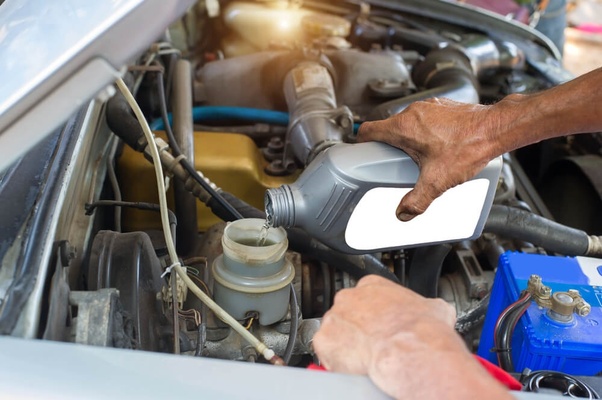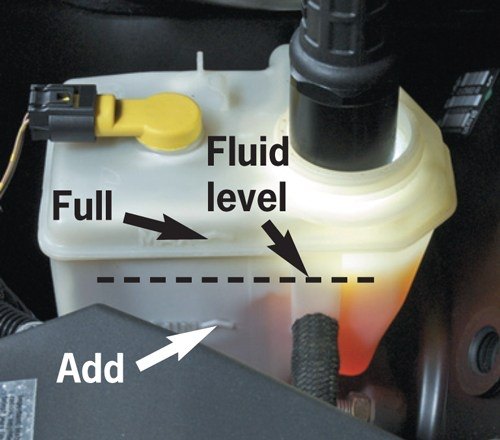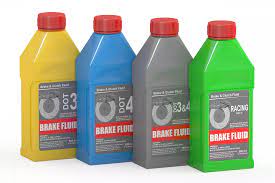Maintaining proper brake fluid levels is essential for optimal braking performance.
This guide, written by automotive experts, will answer your questions about adding brake fluid safely and effectively.
We’ll cover whether the engine needs to be off and cool when adding brake fluid, the correct type of fluid for your car, and step-by-step instructions to ensure a smooth and safe process.
Can I Add Brake Fluid With The Engine Running?

No, turn off your engine and let it cool down completely before adding brake fluid.
Your car’s brake fluid reservoir is usually located close to the engine.
When the engine is running, it heats up, and the parts around it get hot too.
This includes the brake fluid reservoir itself.
Adding any kind of fluid to your car can be a bit messy, and brake fluid is no exception.
Even a small spill can happen during the process.
Brake fluid is a flammable liquid, meaning it can easily catch fire if exposed to high heat.
If you spill brake fluid on a hot engine component while the engine is running, it could ignite and cause a serious fire.
Safety First! Because of this risk, it’s important to always turn off your engine and let it cool down completely before adding brake fluid.
This will help prevent any accidental spills from turning into a dangerous situation.
How To Add Brake Fluid Safely?

Topping up your brake fluid occasionally might be necessary, and the good news is, it’s a task you can often handle yourself!
But remember, safety always comes first when working on your car’s braking system.
Before you dive in, make sure you’ve parked your car on a level surface and set the parking brake.
This will prevent your car from rolling and ensure you can work safely.
Also, grab your car’s owner’s manual.
It’s your best friend to find out the exact type of brake fluid your specific car needs.
Different car models require different fluids, and using the wrong one can mess with your brakes.
Here are a few things you’ll need to get the job done:
- Clean rags or paper towels
- Funnel (with a long neck if possible)
- Approved DOT-compliant brake fluid
Here’s a step-by-step guide to adding brake fluid safely:
- Cool It Down: First things first, turn off your engine and let it cool down completely. This could take up to 30 minutes or even longer depending on how long you’ve been driving. A hot engine means hot parts, and you don’t want any spills landing on something scorching.

- Find the Reservoir: Now, it’s time to locate the brake fluid reservoir. It’s usually a clear or translucent plastic container with a labeled cap tucked away somewhere in your engine bay. If you’re having trouble spotting it, your owner’s manual should have a helpful diagram.
- Clean Up Around the Cap: Before you remove the cap, grab a clean rag and wipe the area around it. You want to avoid any dirt or debris dropping into the brake fluid when you open it up.
- Open Up Carefully: Carefully take off the reservoir cap and place it on a clean surface, like a spare rag.

- Check the Level: Take a look inside the reservoir. You’ll see markings that show the minimum and maximum safe fluid levels. If the fluid level is below the minimum line, then you can move on to the next step. But, if the fluid is already within the recommended range, adding more isn’t necessary.
- Top It Up Slowly: Get your funnel and slowly pour the recommended brake fluid into the reservoir until the level reaches just below the maximum fill line. Don’t go overboard, overfilling can cause problems with your brakes.
- Clean-Up Spills: Spills happen, but with brake fluid, it’s extra important to clean them up right away. Use a clean rag to wipe up any spills immediately. Brake fluid can damage your car’s paint, so be super careful!
- Cap It Off: Once you’re done adding fluid, put the reservoir cap back on securely and make sure it’s nice and tight.
Expert Tips:
- Never reuse leftover brake fluid. Over time, it absorbs moisture, which can make it less effective.
- Don’t mix different types of brake fluid in your reservoir. Always use the type recommended by your car’s manufacturer.
- If your brake fluid level seems to be dropping all the time, it might be a sign of a leak in the system. In this case, play it safe and take your car to a qualified mechanic for a professional inspection.
What Happens If I Add The Wrong Type Of Brake Fluid?

Using the wrong brake fluid can damage brake components and reduce braking performance, both of which are major safety risks.
Different brake fluids have varying chemical compositions.
If you use a fluid not recommended for your car (like using DOT 5 where DOT 3 or 4 is specified), it might be incompatible with the seals and hoses within the braking system.
Over time, this incompatibility can lead to these components breaking down and developing leaks.
Leaking brake fluid can compromise the entire braking system and lead to potential brake failure.
This is a major safety hazard and should be addressed immediately.
Another important factor is the brake fluid’s boiling point.
This refers to the temperature at which the fluid starts to vaporize and turn into gas bubbles.
These bubbles are highly compressible, they can easily compress under pressure.
In your brakes, that’s bad news!
When you press the brake pedal, the brake fluid transfers heat away from your brakes.
If the fluid has a low boiling point and boils due to the heat generated during braking, those gas bubbles can form and compress easily.
This results in a spongy brake pedal feel and a significant reduction in your car’s stopping power.
This can be extremely dangerous in emergencies where quick and reliable braking is essential.
Please note, that when it comes to brake fluid, sticking to the recommended type specified in your car’s owner’s manual is essential for maintaining safe and reliable braking performance.
What Type Of Brake Fluid Do I Need For My Car?

There are different DOT classifications (like DOT 3, DOT 4, DOT 5) for brake fluids, but figuring out the recommended brake fluid type for your car can be tough.
DOT stands for Department of Transportation, and they classify brake fluids based on their boiling point.
This boiling point refers to the temperature at which the fluid boils and turns into gas bubbles.
These bubbles are bad news for your brakes because they’re easily compressed, making your brake pedal feel spongy and reducing your car’s stopping power.
Higher DOT numbers generally show the fluid can withstand higher heat before boiling.
Here are a few ways to identify the compatible brake fluid for you.
- Check Your Owner’s Manual: Your car’s manual will explicitly state the exact DOT type of brake fluid required for your specific vehicle.
- Look for Markings on the Brake Fluid Reservoir Cap: Many brake fluid reservoir caps have the recommended DOT type conveniently labeled for your reference.
- Consult a Qualified Mechanic: If you’re unsure about the appropriate DOT type after checking the manual and cap, a mechanic can help you identify the correct brake fluid for your car.
Don’t experiment with brake fluid, using an incompatible brake fluid can compromise your car’s braking performance and lead to safety hazards.
Always stick to the recommended DOT type specified in your car’s manual for optimal braking performance.
Reference Sources:
